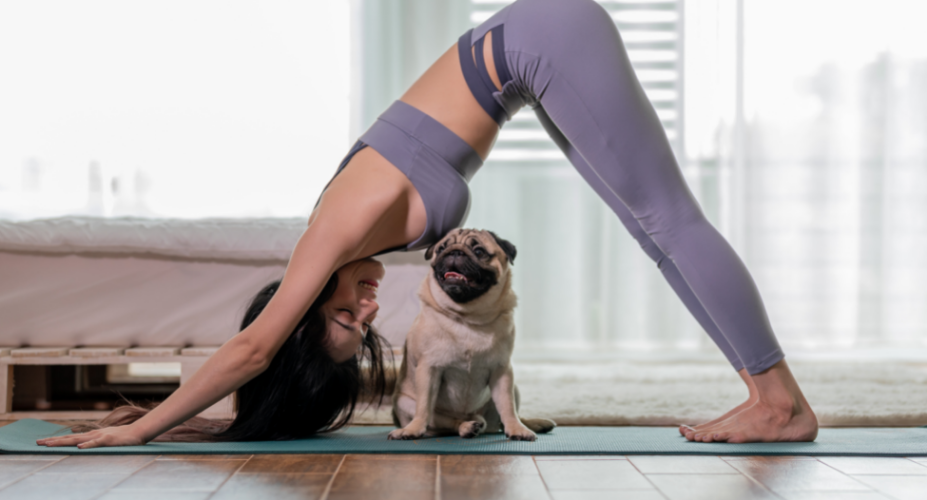
Ease your aching muscles with this accessible flow.
Most runners finish a training session knowing that doing some kind of stretching or recovery work is a wise move, but knowing something and actually doing it are very different things. It’s hard to motivate yourself to do anything other than slump on the sofa when you get home, especially after a long training run.
You can make it easier on yourself in a couple of ways. First, don’t try and do too much – a solid five to 15 minutes of stretching will work wonders, you don’t have to spend ages on your immediate recovery. Second, it doesn’t even have to be immediate. Have a shower and some food and generally sort yourself out. Then, before you completely crash out, try this five-move yoga sequence created and explained by Gemma Soul, head of yoga at Psycle London.
“Yoga is an excellent form of exercise for recovery after long runs as even a small amount of movement can go a long way towards getting you to your next starting line, or regaining that bounce in your step,” says Soul.
Make sure you do all stretches on both sides, and try to stay in each stretch for a couple of minutes to help your body recover more quickly after a run.
Downward-facing dog

Why Downward-facing dog is a great move to open the shoulders, lengthen the spine and back, and stretch through the hips, hamstrings, calves and achilles. It’s important when you’ve been firing on all cylinders in one plane of movement to help your body create space in your joints and start to release the lactic acid and cortisol from the muscle tissue.
How Star on all fours, tuck your toes under and lift your knees off the floor. Hike your hips back until your chest and shoulders start to draw up and away from your wrists. Then start to pedal your legs, bending one knee and then the other. It’s important to breathe slowly and deeply, and move slowly – show some compassion for your sore body!
Crescent lunge

Why Lunging helps to stretch the hip flexors and the quads, which work overtime during a long run. Every time you pick up your feet to take a step, it shortens your hip flexors. The impact on the knees from running will probably mean they feel stiff, so starting to get a little more movement in the knee joint is also beneficial.
How From downward-facing dog, lift one leg and then place the foot between your hands, drop your back knee and bring your arms into the air. If you feel a little wobbly then bring your hands onto your front thigh. Stay in this position for a minute or two if you can. If you want to progress, bring one hand down to the floor in front and take hold of your back foot to access your quadriceps and hip flexors even more.
Ninja lunge

Why This lunge opens the adductors (inner thighs) and starts to stretch the hamstrings and hips a little more deeply. If you can bear to stay up on the ball of your front foot then you also lengthen the fascia on your sole and stretch the arch of your foot, which has been taking the hit of your bodyweight for the duration of your run.
How From the crescent lunge position, turn to the side and lift your back foot so it’s flexed. Support the pose with your hand on the floor and ease yourself into the stretch, going as deep as you can without causing pain (especially in the bent knee). If you want to take it deeper then start to move your chest a little lower to the floor with an extended spine.
Wide-legged forward fold with bound arms

Why Your posture will have been slightly rounded for a few hours, with your shoulders internally rotating. The weight of your head has also probably been slightly forwards, beyond your centre line, and this will cause a stress on your upper back and neck. This pose allows your spine and neck to lengthen with gravity and binding your arms also allows your chest and shoulders to open. Squeeze your shoulder blades together to make sure your shoulders are drawing, not collapsing, back. Being in a wide-leg stance allows a deeper stretch of the hamstrings and glutes.
How From the ninja lunge, lift your hips and turn your feet so that you are ever so slightly pigeon-toed. If you are very tight then allow your knees to bend slightly but get your weight forwards so you can let go through your upper body. Clasp your hands behind your back, squeeze your shoulder blades together, and lift your arms and shoulders, then take them over your head. Hold a strap or a towel if your shoulders are too strong or tight to clasp your hands together.
Pigeon

Why The pelvis is the centre of your body. Your legs come out of it and your spine up from it, so it is effectively floating in the middle, which means there is a lot of interconnected muscles and connective tissue that keep everything stable. Pigeon pose allows these muscles and tendons to start to release and lengthen, particularly the glutes, psoas (a deep-seated core muscle) and IT band.
How From your forward fold, turn to your front right leg and bring it across so your right knee is behind your right wrist and your right ankle is somewhere behind your left wrist, or under your belly if you are a little tight. Extend your left leg further back and release your chest forwards. If this is painful on your knee, turn onto your back and place your right ankle on your left thigh instead.
Written by Nick Harris-Fry for Coach and legally licensed through the Matcha publisher network. Please direct all licensing questions to legal@getmatcha.com.


